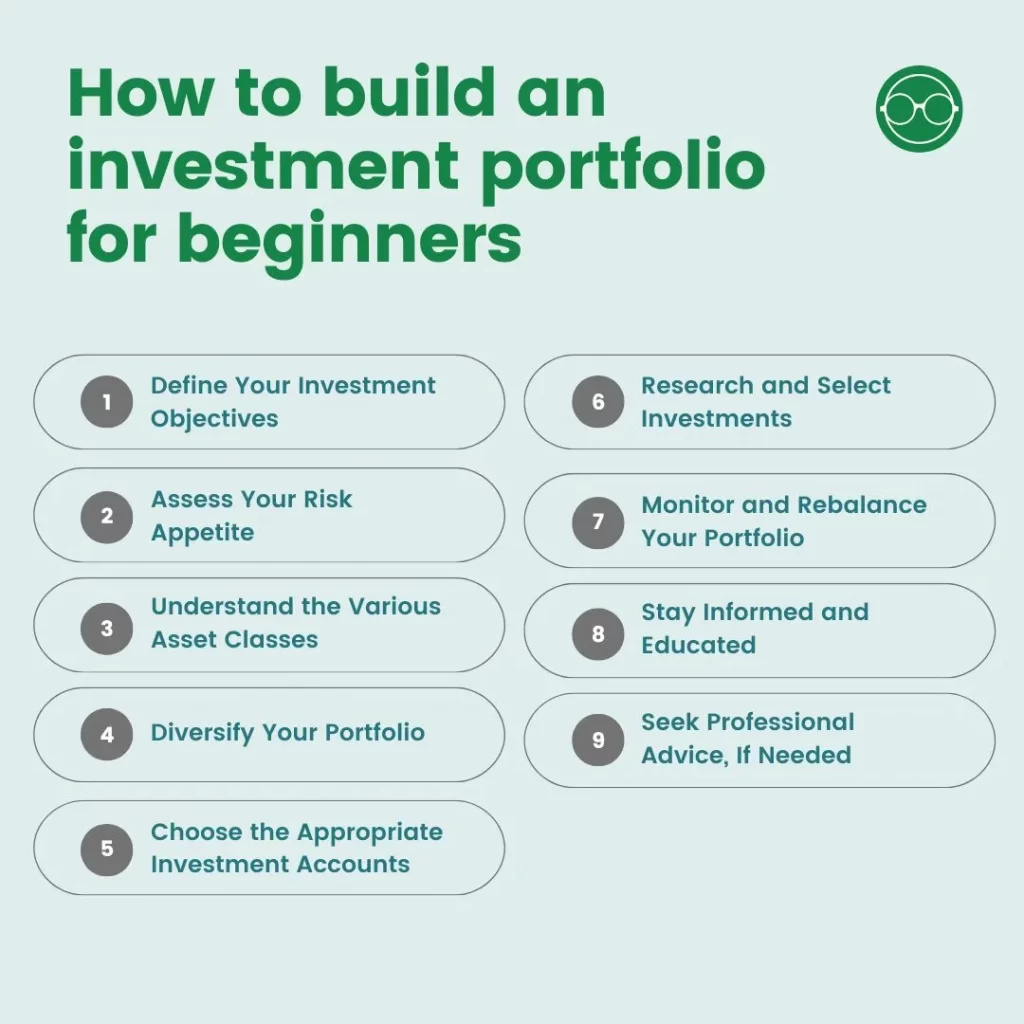This post may contain affiliate links. We may receive compensation when you click on links to those products at no additional cost to you. Read our full disclosure here.
If you’re looking to build an investment portfolio and don’t know where to start, I got you! An investment portfolio is crucial to achieving one’s financial goals as it provides the framework for how your money will grow.
Before we get into the different steps on how to build an investment portfolio for beginners, a few disclaimers I want to point out:
- This is NOT financial advice. The content is meant for educational purposes to give you some ideas on how to get started.
- There is no perfect or “correct” portfolio. Your portfolio is what suits you and your preference best.
- This article is meant for beginners and those who have a “simpler” financial situation. If you have a lot of moving parts and need more expertise in building out your investment portfolio, please seek a professional!
How to Build an Investment Portfolio for Beginners

1. Define Your Investment Objectives
The foremost step in constructing an investment portfolio entails clearly defining your investment objectives.
- What are the purposes behind your investments?
- Is it for retirement savings?
- Purchasing a property?
- Funding your children’s education?
Precisely identifying your goals will assist you in determining the investment horizon and the appropriate risk level.
Action item: Jot down your investment objectives along with the associated timeframes. This exercise will aid in assessing the required savings and guide you toward suitable investment strategies.
Read more about how to define your investment goals here.
2. Assess Your Risk Appetite
Understanding your risk appetite is crucial while formulating an investment portfolio.
Risk appetite is your capacity to endure fluctuations in the value of your investments and can range from Your risk appetite can range from conservative to aggressive.
A great question to ask yourself: “If your investment loses 50% of its value tomorrow, how would you feel?” If that statement makes you queasy, you may be more risk-averse than you think.
If you possess a longer investment horizon and can withstand short-term volatility, you may consider assuming more risk in pursuit of potentially higher returns.
Conversely, if you have a shorter investment horizon or are uncomfortable with market fluctuations, adopting a more conservative approach may be prudent.
Action item: Undertake a risk tolerance assessment questionnaire to ascertain your comfort level with risk. This assessment will facilitate the alignment of your investment strategy with your risk tolerance.
3. Understand the Various Asset Classes
To establish a well-rounded investment portfolio based on your risk appetite and goals, it is imperative to have a comprehensive understanding of different asset classes.
Common asset classes encompass:
Each asset class possesses its unique risk and return characteristics. Equities, for instance, are renowned for their potential for high returns but are accompanied by higher risk and volatility.
Conversely, fixed-income securities tend to exhibit more stability but offer relatively lower returns.
You don’t need to be an expert in every asset class; simply understanding their characteristics and how they interconnect is sufficient to make an informed decision.
Action item: Engage in research to learn about different asset classes and their distinguishing features. This research will enable you to determine the appropriate allocation of your portfolio based on your risk tolerance and investment goals. Utilize Google, YouTube, and ChatGPT to your advantage here!
4. Diversify Your Portfolio
Diversification is a fundamental principle in constructing a successful investment portfolio. It entails spreading your investments across various asset classes, industries, and geographical regions that are uncorrelated or even negatively correlated with each other.
Through diversification, you can reduce the impact of any individual investment’s performance on the overall portfolio. This approach can safeguard your investments during market downturns and increase potential returns.
Read more about the pros and cons of diversification here.
Action item: Plan to allocate your investments across multiple asset classes, ensuring that no single investment constitutes a significant proportion of your portfolio. Use tools like Empower to perform an investment checkup on your current portfolio’s asset allocation.
5. Choose the Appropriate Investment Accounts
Crafting a well-rounded investment portfolio hinges on the careful selection of suitable investment accounts.
There are various investment accounts, including individual retirement accounts (IRAs), 401(k)s, brokerage accounts, and more. Each account type adds its own flavorful blend of tax advantages and limitations to the mix.
It is crucial to conduct thorough research and comprehend the features and restrictions of each account before deciding where to allocate your capital.
I’ve written more about the various investment plans and accounts here if you want to learn more.
Action item: Evaluate different investment account options based on your investment goals and tax considerations. Open the relevant accounts that align with your long-term objectives. Set up automatic contributions if you can to “pay yourself first”.
6. Research and Select Investments
Once you have defined your goals, assessed your risk tolerance, and decided on the appropriate asset allocation, it is time to conduct thorough research and carefully select specific investments.
This step involves analyzing individual stocks, bonds, mutual funds, exchange-traded funds (ETFs), or other investment options.
As you can see, we have used a more top-down approach to select investments. From the broader asset class at the top, we’re drilling down to the more specific investments at the bottom.
Action item: Utilize tools like Morningstar and Yahoo Finance to research factors such as historical performance, expense ratios, risk, outlook, and alignment with your investment strategy. Be sure to diversify when you consider these investments.
7. Monitor and Rebalance Your Portfolio
Constructing an investment portfolio is not a one-time endeavor. It necessitates ongoing monitoring and periodic rebalancing.
Monitoring involves keeping a close eye on the performance of your investments and staying informed about market trends and economic developments.
Regularly reviewing your portfolio will enable you to identify underperforming investments or asset classes that may require adjustments.
Action item: Establish a regular schedule for portfolio review. That can be monthly, quarterly, or annually. Monitor the performance of your investments and make necessary adjustments as circumstances dictate. Consider rebalancing your portfolio at least once a year to maintain your desired asset allocation.
8. Stay Informed and Educated
The realm of investing is ever-evolving, and it is essential to stay informed and continuously educate yourself about new developments and investment strategies.
Stay abreast of financial news, follow reputable investment blogs, and consider enrolling in courses or attending seminars to enrich your investment knowledge.
By remaining well-informed, you can make more thoughtful decisions and adapt your investment strategy as needed.
Action item: Stay updated with financial news and avail yourself of relevant resources. Subscribe to reputable investment publications and newsletters. Participate in webinars or seminars to broaden your knowledge and comprehension of investing.
9. Seek Professional Advice, If Needed
While constructing an investment portfolio is certainly something you can undertake on your own, there may be instances where seeking professional advice can prove beneficial, especially if you find yourself dealing with complex financial situations or specific investment goals.
Financial advisors can provide personalized guidance based on your unique circumstances and assist you in navigating the world of investing. Money and investing are emotional things so having a third-party can be helpful in overcoming common investor biases.
Action item: If you feel overwhelmed or require expert guidance, seek the assistance of a qualified financial advisor. Conduct thorough research and carefully select an advisor who comprehends your needs and upholds a fiduciary duty to act in your best interest.
Conclusion
Learning how to build an investment portfolio for beginners is definitely doable. As long as you are willing to learn, diversify your risk, and stay disciplined and consistent, you are well on your way to financial freedom!
FAQs
What is the purpose of building an investment portfolio?
Building an investment portfolio allows individuals to grow their wealth over time by strategically allocating their money to various financial instruments.
It provides an opportunity to achieve financial goals, such as retirement savings, purchasing a house, or funding education, by harnessing the potential of returns of different asset classes.
How do I define my investment goals?
Defining investment goals involves determining what you are investing for. Consider factors like retirement, major purchases, or specific financial milestones. By clearly identifying your goals, you can establish the investment horizon and risk level that aligns with your aspirations.
How can I assess my risk tolerance?
Understanding your risk tolerance is crucial for constructing an investment portfolio. It refers to your ability to tolerate fluctuations in the value of your investments.
Assessing risk tolerance involves considering factors such as investment horizon, comfort with market volatility, and financial circumstances. You can use risk tolerance assessment questionnaires to evaluate your comfort level.
What are the different asset classes?
Asset classes are categories of investments with similar characteristics. Common asset classes include stocks, bonds, real estate, and cash equivalents.
Each asset class carries its own level of risk and potential returns. Diversifying across different asset classes helps to spread risk and enhance the chances of achieving investment goals.
Why is diversification important in an investment portfolio?
Diversification is crucial in an investment portfolio as it helps reduce risk. By spreading investments across different asset classes, industries, and geographic regions, you minimize the impact of any single investment’s performance on the overall portfolio.
Diversification aims to balance risk and potential returns, protecting investments during market downturns.
This post may contain affiliate links. We may receive compensation when you click on links to those products at no additional cost to you. Read our full disclosure here.






